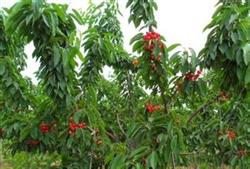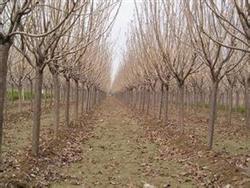Early High-yield and High-quality cultivation techniques of Big Cherry

For a long time, it has been generally believed that big cherries bear fruit late and have low yield, unlike other fruit trees, which can be cultivated in early high yield. In fact, this is only an illusion caused by the long-term use of traditional cultivation and management techniques. Since the late 1990s, our county has adopted free spindle pruning, combined with spring bud carving, autumn twig pulling, summer ring peeling, application of growth inhibitors, re-coring of tender shoots, and increasing application of phosphorus and potassium fertilizer, so that the early high yield of cherry has become a reality. The fruit can be seen in the third year after planting, 500kg in the fourth year and 2050kg in the sixth year after planting. The key cultivation techniques are summarized as follows. 1Seedling selection and colonization. 1.Seedling selection selects 2-year-old seedlings whose basal diameter is not less than 1cm and root system is intact. The ratio of main varieties to pollinated varieties is not less than 7:3. 1.2 planting density generally, under the condition of deep soil layer and high soil fertility, the plant-row spacing of 3mx4m and 4mx5m is suitable, and the land with thin soil layer and poor fertility can appropriately increase the planting density. 1.3.The large hole of 1 m square and 0.6 m deep was dug before planting. When backfilling, each hole was treated with 25~50kg soil manure and 0.5kg special compound fertilizer for fruit trees, mixed evenly and filled into the bottom of the hole. Only fill the cooked soil in the 30cm soil layer from the ground, and then pour through the water to settle. When planting, dig small holes, straighten the seedlings, and stretch the roots, then be firm and watered. Cover with 1m2 mulch. (2) soil, fertilizer and water management 2.1 Deep ploughing and mid-ploughing combined with autumn application of base fertilizer, the depth is about 60cm. The deep turning area of the tree with fruit should not be too large, but should be widened and deepened year by year. Three or four times of intertillage and weeding are carried out every year. 2.2 rational fertilization. 30~60kg organic fertilizer was applied to each young tree and early fruit tree every year, and ternary compound fertilizer 0.1~0.5kg was added to each tree. When the tree entered the full fruiting stage, the application rate was calculated according to the proportion of 3kg organic fertilizer applied per fruit 1kg, and 1~1.5kg was added to each tree. 0.5% urea + 0.5% potassium dihydrogen phosphate was sprayed during fruit expansion and shoot growth. 2.3 watering 3-5 times a year, that is, pre-flowering water, fruit-promoting water, postharvest water and frozen water. Each watering is combined with topdressing. The early orchard can be watered once or twice as appropriate. Pay attention to drainage in the rainy season. (3) Flower promotion technique 3.1 before sprouting (March 8-25), a small saw blade was used to saw half a circle horizontally at the 0.2~0.5cm above the bud, reaching to the xylem. Too shallow, has little effect on sprouting, too deep, slow healing, easy to flow glue, easy to break in case of wind. 3.2 it is most suitable for girdling from May 6 to May 25. If the ring is peeled too late, it is easy to flow glue, and the effect of flower formation is poor; prematurely, it is easy to cause tree weakness and low fruit setting rate. The girdling site should be at the base of the primary branch, not in the middle of peeling, otherwise the tree will die easily. The width of girdling should be less than 0.5cm, and 0.1~0.2cm is suitable. 3.3 the suitable time for branch drawing is from mid-August to mid-late September. The suitable angle of branch pulling is 80-85 degrees, which is too large, and it is easy to sag after fruiting; too small is not conducive to ease the tree potential and flower formation. Pulling branches in autumn can not only ease the tree potential, promote short branches, but also promote flower formation. 3.4 multiple coring is mainly carried out on young and prosperous trees, in order to control the growth of branches, increase the number of branches and branches, promote the transformation of branches, and accelerate the expansion of the crown. If the heart is not plucked, when there are many branches growing on a branch, a large number of leaf branches produced by carving buds in the back will die. When the long branches grew above 10cm in the first and middle of May, the first coring was carried out, leaving 5~6cm, and then the secondary and tertiary branches germinated, leaving 4-5 leaves for continuous coring until they stopped growing. 3.5 Application of paclobutrazol to young and prosperous cherry trees. The spraying times depend on the growth and development of the tree, the vigorous ones can be sprayed for 1 or 2 times, and the new shoots around the crown can be sprayed with 200 times liquid once after the middle of May, and once again at an interval of half a month. The first application of soil can be carried out in mid-late March or from September to October. Generally, 15% paclobutrazol is applied to plants. The application site was applied in the vertical projection of the new shoots outside the crown, and the ring ditch was opened. (4) Flower and fruit management 4.1 artificial pollination can be either manually pollinated or pollinated. Click manually and dip the pollen on the stigma of the flower with a brush or rubber head. Generally speaking, the first or second day of blooming of the flower is the best. 4.2 insect pollination insects are currently most commonly used by honeybees, and bumblebee pollination has achieved excellent results in recent years, especially in facility cherry orchards. Bumblebee pollination of facility cherries can increase the fruit setting rate, increase the number of fruits and promote the early ripening of fruits. 4.3 Flower thinning and fruit thinning is generally carried out before flowering, mainly removing small flower buds and deformed flower buds on thin and weak branches, and retaining 2-3 full and strong flower buds. Fruit thinning is usually carried out after physiological fruit drop in the middle of April. The degree of fruit thinning depends on the growth of the tree and the setting of fruit. Generally, a bouquet-shaped fruit branch can have 3-4 fruits, up to 4-5 fruit. When thinning fruit, it is necessary to remove small fruit, deformed fruit and drooping fruit with poor coloring. 5 pest control in our area, cherry diseases are mainly gummy disease, perforation disease, leaf spot disease, insect pests are leaf mite, apple leaf moth, diamondback moth, caterpillar, pear heart borer and so on. Spray the mixture of stone and sulfur 1 / 2 times and 3 / 5 degrees before germination in spring. Leaf mites were used alternately with nisolang, triazolam, triazotin and so on. The perforation disease was prevented and treated with mancozeb mixed with agricultural streptomycin. Apple leaf moth, pear heart borer, diamondback moth, caterpillar and so on were sprayed with pyrethroid pesticides for control. Insect pests such as diamondback moth and caterpillar are removed and destroyed before their egg stage and larvae spread.
- Prev

Control methods of main diseases and insect pests in loquat
Loquat is evergreen all the year round, blossoms in autumn and winter, bears fruit in the same year, and is harvested next year. It begins to blossom in September, and the florescence lasts as long as 2mi for 3 months. If you protect the flowers and fruits safely through the winter (more than 10% of the flowers and fruits), you will be able to reap a bumper harvest. But after loquat harvest that year (May-June) to harvest fruit in the coming year, during which due to the occurrence and damage of various diseases and insect pests.
- Next

Key points of Summer Management of Big Cherry
Autumn is the peak of root growth of fruit trees, and it is also the key period for trees to accumulate nutrients. At present, there are many ways to fertilize Yantai cherry. When it comes to the essentials of applying base fertilizer in autumn, we should first highlight the word "early". It is generally carried out from September to October, but the effect of early application in September is better.
Related
- Moge, come on! The staff of the peasant association in the producing area of cantaloupe were frightened when the crowd gathered.
- Causes and Solutions of low Fruit setting rate of Apple
- Symptoms and control measures of passion fruit virus disease
- Fruit growing lesson: how do apple orchards keep high yields?
- Can you build orchards in the mountains? What are the pros and cons?
- How to manage the coloring period of Crisson grape?
- This paper introduces the processing technology of two kinds of fig products.
- How much is a month for retired teachers in rural areas by 2020?
- How can strawberry planting increase sugar content? We should pay attention to management in many aspects.
- What are the cultivation techniques on how to improve the yield of golden fruit?

